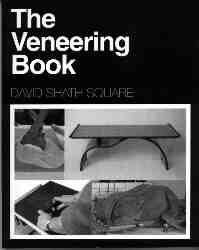 ANNOTATION
ANNOTATION
 ANNOTATION
ANNOTATION
One of the main reasons for referencing this book are the articles on the vacuum press. Apart from the fact that the vacuum press provides the necessary pressure to hold he veneer in place after using a slow hardening glue (not a contact adhesive), it also provides the ability to glue veneers to non-regular surfaces that have both convex and concave surfaces.
The first three chapters talk about the basics of veneering and the recent revival of the technique. They also cover the two methods of hammer and mechanical ways of adhering the veneer. The reminder of the book is devoted to the vacuum press, including a chapter on how to make one. Although I have no personal experience with anything other than a regular flat surface or using the vacuum press, I do look forward to doing so in the future (Dec. ’96).
If anyone reading this has any experience with veneering irregular surfaces particularly concave or convex ones, I would appreciate hearing from you. I have had several requests for advise.
COVER
Woodworkers of earlier generations created spectacular furniture using veneer, but traditional methods often were messy and required patience and special skills.
In recent years, concern for the environment and the scarcity of select hardwoods have given woodworkers good reasons to take a second look at veneering. Veneering provides the means of using beautiful figured woods at a fraction of the cost of solid wood. It also allows woodworkers to use more stable substrates such as plywood and MDF and still achieve beautiful effects.
Vacuum veneering, one of the few true innovations in woodworking technique in recent years, has made the process of veneering much more accessible to all woodworkers. While this book covers the basics of a variety of veneering techniques, including traditional methods, the heart of the book is a thorough introduction to vacuum veneering and practical advice on how small-shop woodworkers can use veneering and lamination in their woodworking.
David Shath Square studied woodworking with John Makepeace and John Sainsbury in England. He has been a professional woodworker since 1977. For the last five years, he has worked exclusively with veneer in his furniture making. Currently, he lives in Tyndall, Manitoba, Canada, and contributes to a number of woodworking publications, including Fine WoodWorking. David Shath Square
The Taunton Press publishes books, videos and magazines about woodworking,
home building and fiber arts. For out complete catalog, write to:
Taunton Press
63, Sount Main Street,
Box 355,
Newtown, CT
06470